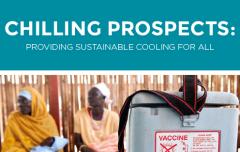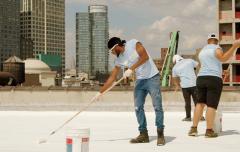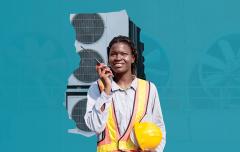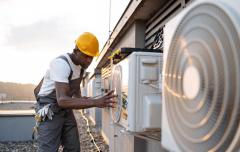Cool roofs: simple, affordable solution for curbing urban heat
NEW YORK CITY – From the roof of an eight-story building at 941 Hoe Street in the South Bronx, I have a sunny panoramic view of concrete and pavement. High-rise buildings stretch out like a sea in front of me, crisscrossed by asphalt-laden streets and highways. I also see dark-colored rooftops.
Highlights
It’s no wonder it is so hot in the city.
“It was even hotter yesterday. It felt like 2,000 degrees,” said Bryan Contreras, who is standing next to me on the roof.
Contreras is one of 30 workers with a brush in his hand and a big bucket of white acrylic coating at his feet. They are coating this 36,000-square-foot rooftop white – part of a citywide NYC °CoolRoofs brigade that is trying to make the city’s extreme heat a little less extreme.
The cool-roof idea is simple, but its impacts can be profound, and not just in New York City where heatwaves kill more people every year than all other extreme weather events combined. While dark roofs absorb heat, making nearby surroundings hotter, white roofs reflect heat, making scorching hot days a few degrees cooler.
This sprawling football field-sized roof is telltale proof. When the three-day project began, it was 110 degrees Fahrenheit (43° Celsius) on the darkened roof; after applying the reflective paint, temperatures were 20 to 30 degrees cooler.
“A dark roof can reach temperatures of 150 degrees Fahrenheit (65° Celsius) in the sun and cool-roof coating can reduce that by as much as 50 degrees,” said Toby Sheppard Bloch, who coordinates the city’s °CoolRoof program, which is done in partnership with the NYC Department of Small Business Services. “We routinely see temperatures drop by 35 degrees within a few hours of applying the coating.”
Cool-roof programs like this are gaining popularity all over the world as climate change is sending temperatures higher. They are especially popular and important in cities, which are especially vulnerable to extreme temperatures due to limited vegetation and excessive amounts of heat-absorbing surfaces – what experts call the “urban heat island effect.” New York City is projecting up to a 5.7 degree Fahrenheit increase in average temperatures and a doubling of days over 90 degrees Fahrenheit by the 2050s in the city due to global warming.
We’re already seeing the dire implications of spiking temperatures, with hundreds of people dying this summer due to unrelenting heat in cities such as Montreal, Canada, Kyoto, Japan and Karachi, Pakistan. Many of the victims are the poor and elderly who don’t have access to air conditioners and cooler indoor spaces.
A recent report by Sustainable Energy for All quantifies the enormity of the challenge. It estimates that over 1.1 billion people, including 630 million living in urban slums, lack access to basic cooling services that they need to survive and thrive in hotter climate regions. Some of the biggest at-risk populations are in ever-denser cities in Asia and Africa, where electricity is unavailable, unreliable or beyond their financial means. Lacking electricity means these people cannot run a cooling fan or an air conditioner when temperatures rise.
More cities are recognizing the importance of heat mitigation programs, with New York City being one of the early adopters. The city’s $100 million Cool Neighborhoods program targets poor vulnerable neighborhoods with the highest exposure to heat-related illnesses. Among its priorities are more shade, green and canopy cover, lighter-colored sidewalks and heat-risk training for home health aides. Another key priority is its decade-old °CoolRoof program, in which 70 workers are re-coating up to one million square feet of rooftops every summer.
Most of the schools, hospitals and residential buildings getting cool roofs are in the South Bronx, Upper Manhattan and Central Brooklyn. “We map them out by zip-code and they all fall in a socio-economic rung of the ladder that’s at the bottom,” said Thomas Perry, who is overseeing the cool roof project in the South Bronx.
How much cooler can we make our cities? According to a New York City report, installing a cool roof can lower internal building temperatures by up to 30 percent in the summer and lower air conditioning costs by 10 to 30 percent. A more comprehensive 2014 study shows that green roofs with relatively abundant moisture cooled air temperatures by up to 3.5°Celsius over the Baltimore, Maryland–Washington, D.C. metropolitan area, and a cool roof with a reflectivity of 0.7 reduced air temperatures by 3° Celsius.
Other communities are taking a cue from New York City’s successful efforts – among those, Ahmedabad, a city of 6.3 million in western India. After a devastating heatwave in 2010, Ahmedabad developed Southeast Asia’s first comprehensive heat action plan targeting vulnerable neighborhoods, including slums. The program includes cool roof retrofits, color-coded heat warnings announced in the media and social workers going door-to-door handing out dehydration packets and pamphlets on heat safety.
Evaluations between 2013 and 2015 show the program is working. Heat-related fatalities in the city were low during a 2015 heatwave, while thousands died elsewhere across India. As of June 2017, 17 cities and 11 states across India had released or were developing heat action plans.
Kurt Shickman, executive director of the Global Cool Cities Alliance, says there are many more examples of communities, large and small, that are prospering by cooling down. One of his favorite examples is !Kheis, a community of 15,000 in one the hottest parts of South Africa.
As Shickman wrote in a recent blog, homes in !Kheis were routinely too hot to enter during the day and families often have to sleep outside. The community also lacked job opportunities for many of its residents. Several years ago, the municipal manager piloted a series of highly reflective cool coatings on several homes. Residents immediately noticed the temperature difference and improvements in comfort, which led to a bigger rollout (about 500 homes have been coated so far).
Job training and career opportunities are important features of both the !Kheis and the New York City programs.
Workers in New York City’s program get 10 weeks of employment and job training for future employment. Among those participating in the city’s newest cool-roof brigade is Bellease Bass, 45, a resident of the South Bronx. Despite 90 degree temperatures and a blistering sun, she is all smiles as she takes a brief break from painting.
“It’s definitely hot, but I’m totally psyched,” said Bass, whose face is dripping with sweat. “It’s a great opportunity … one we don’t often get these days.”





